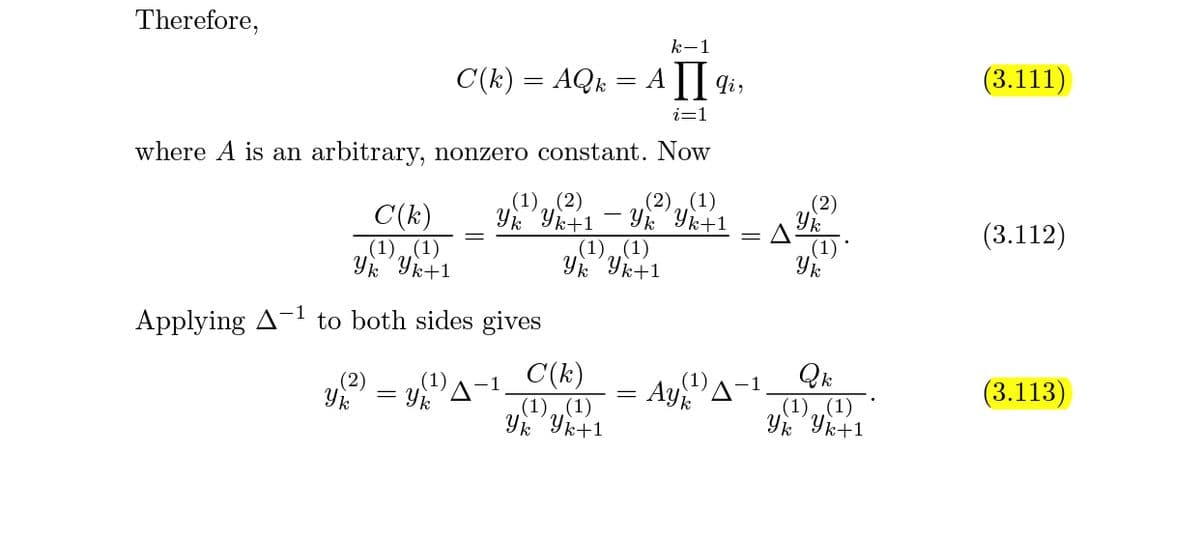Example A Assume that we know that one solution of the equation Yk+2 – k(k + 1)yk = 0 (3.146) LINEAR DIFFERENCE EQUATIONS 103 (1) is y = (k – 1)!. We wish to find a second linearly independent solution. From equation (3.146), we see that qk = -k(k + 1). (3.147) Substitution of this into equations (3.111) and (3.113) gives Yk = (-1)*(k – 1)!. (3.148) Therefore, the general solution to equation (3.146) is Yk = [c1 +c2(-1)*](k – 1)!, (3.149) where C1 and C2 are arbitrary constants. Note that the Casoratian is C(k) = (-1)*+1(k -– 1)!]²(2k), (3.150) (2) (1) and Yk thus showing that Yk are linearly independent.
Example A Assume that we know that one solution of the equation Yk+2 – k(k + 1)yk = 0 (3.146) LINEAR DIFFERENCE EQUATIONS 103 (1) is y = (k – 1)!. We wish to find a second linearly independent solution. From equation (3.146), we see that qk = -k(k + 1). (3.147) Substitution of this into equations (3.111) and (3.113) gives Yk = (-1)*(k – 1)!. (3.148) Therefore, the general solution to equation (3.146) is Yk = [c1 +c2(-1)*](k – 1)!, (3.149) where C1 and C2 are arbitrary constants. Note that the Casoratian is C(k) = (-1)*+1(k -– 1)!]²(2k), (3.150) (2) (1) and Yk thus showing that Yk are linearly independent.
Algebra & Trigonometry with Analytic Geometry
13th Edition
ISBN:9781133382119
Author:Swokowski
Publisher:Swokowski
Chapter5: Inverse, Exponential, And Logarithmic Functions
Section5.6: Exponential And Logarithmic Equations
Problem 64E
Related questions
Question
100%
Show me the steps of determine
!,
(3.149)
where
C1
and
C2 are arbitrary constants. Note that the Casoratian is
C(k) = (-1)*+1[(k – 1)!²(2k),
(3.150)
(2)
thus showing that
Yk
* and y are linearly independent.](/v2/_next/image?url=https%3A%2F%2Fcontent.bartleby.com%2Fqna-images%2Fquestion%2F0f489e5f-8218-4985-b2fc-608dc0c28410%2F970f0d62-1c7a-402d-84c6-390f115e090b%2Fvqo9z3_processed.jpeg&w=3840&q=75)
Transcribed Image Text:Example A
Assume that we know that one solution of the equation
Yk+2 – k(k + 1)yk = 0
(3.146)
LINEAR DIFFERENCE EQUATIONS
103
(1)
is Yk
(k – 1)!. We wish to find a second linearly independent solution.
From equation (3.146), we see that
Ik = -k(k + 1).
(3.147)
Substitution of this into equations (3.111) and (3.113) gives
= (-1)* (k – 1)!.
(2)
(3.148)
Therefore, the general solution to equation (3.146) is
Yk = [C1 + c2(-1)*](k – 1)!,
(3.149)
where
C1
and
C2 are arbitrary constants. Note that the Casoratian is
C(k) = (-1)*+1[(k – 1)!²(2k),
(3.150)
(2)
thus showing that
Yk
* and y are linearly independent.

Transcribed Image Text:Therefore,
k-1
C(k) = AQk = A 1| 4i,
(3.111)
i=1
where A is an arbitrary, nonzero constant. Now
(1)(2)
(2),(1)
(2)
C(k)
.(1),,(1)
Yk Yk+1
Yk Yk+1
Yk Yk+1
(3.112)
(1)„(1)
.(1)
Applying A-1
to both sides gives
C(k)
(1),(1)
Yk Yk+1
(1)A-
Aye
(2)
.(1)
-1
Yk
= Yk
A
(3.113)
(1),,(1)
Yk Yk+1
Expert Solution
This question has been solved!
Explore an expertly crafted, step-by-step solution for a thorough understanding of key concepts.
Step by step
Solved in 2 steps

Knowledge Booster
Learn more about
Need a deep-dive on the concept behind this application? Look no further. Learn more about this topic, advanced-math and related others by exploring similar questions and additional content below.Recommended textbooks for you

Algebra & Trigonometry with Analytic Geometry
Algebra
ISBN:
9781133382119
Author:
Swokowski
Publisher:
Cengage

Algebra & Trigonometry with Analytic Geometry
Algebra
ISBN:
9781133382119
Author:
Swokowski
Publisher:
Cengage